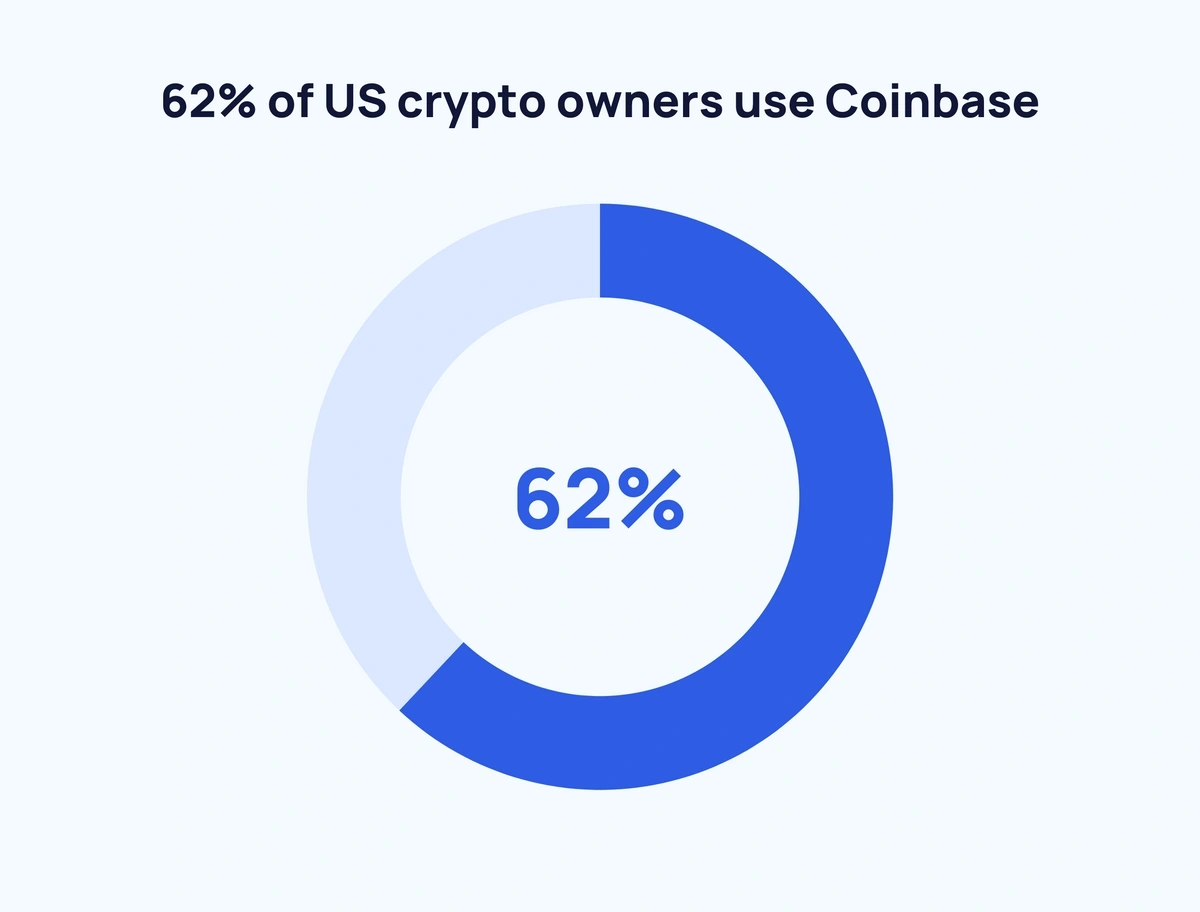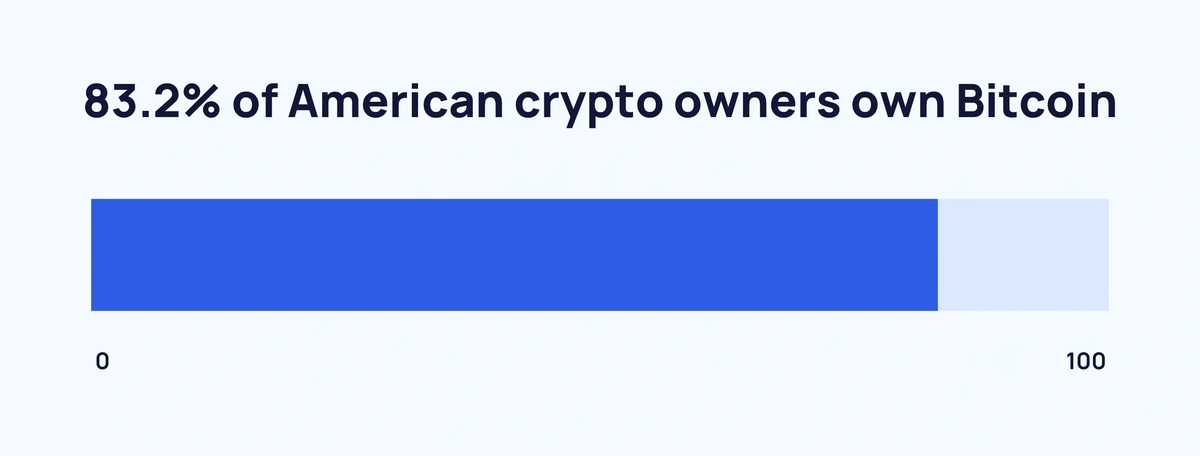
How Many People Use Cryptocurrency? (2024)
Cryptocurrency has exploded over the past decade.
In 2013, there were only 7 cryptocurrencies. Today, there are over 10,000 active cryptocurrencies.
Collectively, cryptocurrencies hold over $2.4 trillion in value.
Contents
- Top Cryptocurrency Statistics
- How Many People Use Cryptocurrency?
- Bitcoin Statistics
- Cryptocurrency by Region
- Crypto Cyberattacks
- Cryptocurrency Trading Statistics
- Cryptocurrency User Statistics
- Crypto ATMs
- Cryptocurrency Mining Statistics
Top Cryptocurrency Statistics
The statistics in this article cover crypto markets, investments, everyday use, and crypto mining. Here are a few of the top stats to get you started:
- There are over 560 million cryptocurrency users worldwide
- Bitcoin makes up around 50% of the total crypto market cap
- Binance users trade over $11.5 billion worth of cryptocurrency every 24 hours
- Bitcoin’s record-high closing price peaked at over $73,000
- There are almost 40,000 crypto ATMs worldwide
How Many People Use Cryptocurrency?
The latest data shows that there are approximately 560 million cryptocurrency users globally.
Source: Triple-A
Bitcoin Statistics
For years, Bitcoin dominated the crypto industry.
The global cryptocurrency market cap (as of July 2024) is $2.2 trillion. Bitcoin makes up around 50% of this.
Yet, that’s a notable decline from 2021 when Bitcoin made up just under 60% of the market.
Bitcoin’s current all-time high price peaked at over $73,000 (March 14th, 2024).
Source: CoinGecko
Cryptocurrency by Region
While crypto has a reputation for being a global currency, using and trading cryptocurrencies is still banned in 51 countries — mostly in Africa and the Middle East.
Data from 2023 suggests that 47% of Nigerians and Turks own or use cryptocurrency.
In 2024, 30% of Argentinians own crypto.
By contrast, only 16% of Americans own or use crypto.
In terms of the distribution of crypto, more than half can be found in Asia (327 million).
Together, the UAE (25.3%) and Singapore (24.4%) account for about half of all Bitcoin ownership.
While cryptocurrencies are currently banned in China, the country has a massive interest in blockchain technology. In 2021, China processed over 16,000 new blockchain patent applications.
However, as of Q1 2024, the US has a 57% share of all patent filings. That’s an increase of 22% on Q4 2023’s 35%.
China has an 8% share of patent filings. And the UK has a 2% share.
In total, 34% of the world’s crypto hedge funds are based out of the tax-friendly Cayman Islands. The United States is close behind at 33%.
As for crypto hedge fund managers, 43% live in the US, 19% in the UK, and 11% in Hong Kong.
Sources: Money.com, Triple-A, Statista, Statista (2), PWC
Crypto Cyberattacks
Hackers have stolen over $75 billion worth of cryptocurrency since June 2013.
As of December 2020, around $15 billion worth of crypto had been lost to exploits, hacks, and scams.
By October 2023, this increased significantly to over $77 billion.
The largest single attack saw approximately $40 billion lost when in May 2022 Terra Classic lost $40 billion in a bank run.
However, as of October 2023, around $6 billion has been recovered.
Hackers stole over $1.38 billion worth of crypto by June 2024, That’s more than double H1 2023’s $657 million.
Cryptocurrency Trading Statistics
People use trading platforms like Binance and Coinbase to trade crypto and track prices.
CoinMarketCap tracks trading volume for 250 different cryptocurrency exchanges.
Binance users trade $11.5 billion worth of cryptocurrency every 24 hours.
Meanwhile, Coinbase’s user base has grown from 23 million verified users in 2018 to more than 110 million today.
In total, 62% of US crypto owners use Coinbase.
Sources: CoinMarketCap, Coinbase, Statista
Cryptocurrency User Statistics
There are over 560 million cryptocurrency users worldwide. That’s an increase of approximately 112x since 2016 (5 million).
Of those, 61% are male and 39% are female.
And almost 3 in 4 (72%) are under 34 years old.
Around 4 in 5 (83.2%) American crypto owners own Bitcoin.
Despite the thousands of cryptocurrencies available, Bitcoin still reigns as the most popular crypto in the US.
Other popular cryptocurrencies include Ethereum (48.7%) and Litecoin (24.7%).
Quick-service and casual dining restaurants are more likely to accept crypto payments than any other business.
A Statista survey of 21,941 companies found that 1,904 quick-service and casual dining restaurants had either cryptocurrency ATMs or accepted crypto as a payment method.
Rounding out the top 5 were:
-
Accommodation (1,159)
-
IT services (1,129)
-
Public ATMs (1,084)
-
Convenience stores and gas stations (958)
Meanwhile, 72% of game development studios are “not interested” in accepting cryptocurrency as payment.
As of 2022, only 1% of game developers reported currently accepting crypto as payment, with 21% saying they were “somewhat interested” and 6% saying they were “very interested”.
However, international B2B blockchain transactions could top $1.7 billion by 2025.
One of blockchain’s earliest advertised benefits was how it would revolutionize cross-border transactions. In the B2B space alone, international blockchain transactions could hit $1.24 billion in 2024.
Sources: Triple-A, Statista, Measure Protocol, Coinmap, Game Developers Conference, Juniper Research
Crypto ATMs
More businesses are starting to use crypto as a payment option, and crypto ATMs are popping up in major cities everywhere.
As of July 2024, there are approximately 38,500 crypto ATMs worldwide.
And owners can now exchange crypto for cash in 70 different countries.
There are currently around 450 crypto ATM operators, down from nearly 500 at the start of 2024.
At the time of writing, the top 10 ATM operators by number of ATMs run 27,818 machines (72.3%).
The remaining 437 operators are responsible for 10,682 ATM machines (27.7%).
Leading the way, Bitcoin Depot has a 19.8% share of all crypto ATMs (7,615 machines).
The top 10 crypto ATM operators are as follows:
|
Rank |
ATM Operator |
Number of ATMs |
Share of Crypto ATMs |
|
1 |
Bitcoin Depot |
7,615 |
19.8% |
|
2 |
CoinFlip |
5,110 |
13.3% |
|
3 |
Athena |
3,319 |
8.6% |
|
4 |
RockItCoin |
2,493 |
6.5% |
|
5 |
CoinHub |
2,027 |
5.3% |
|
6 |
Bitstop |
2,025 |
5.3% |
|
7 |
Margo |
1,744 |
4.5% |
|
8 |
ByteFederal |
1,357 |
3.5% |
|
9 |
Localcoin |
1,307 |
3.4% |
|
10 |
cash2bitcoin |
821 |
2.1% |
In all, Los Angeles has more Bitcoin ATMs than any other US city (1,657 Bitcoin tellers and ATMs).
Other US hot spots include:
- Houston (1,335)
- Chicago (1,115)
- Dallas (1,036)
- Atlanta (842)
Source: Coin ATM Radar
Cryptocurrency Mining Statistics
Crypto mining — the process of validating millions of cryptocurrency transactions — is what leads to the creation of new virtual coins.
More than 93.5% of Bitcoins in existence have been mined.
As of July 2024, there are 21 million Bitcoins in existence and 19,719,968 in circulation.
Bitcoin mining is becoming increasingly harder. The first 90% was mined in 12 years. Miners won’t release the final Bitcoin until around the year 2140.
In total, approximately 38% of all Bitcoin mining takes place in the US. Of this, around 30% of this occurs in the state of Georgia.
Until July 2021, China was the home for most of the world’s Bitcoin mining. However, after China’s implicit ban on crypto use, the US has moved into the top spot.
Here’s a breakdown of the top 5 countries by Bitcoin mining:
| Rank | Country | Average Monthly Hashrate Share |
| 1 | US | 37.84% |
| 2 | China | 21.11% |
| 3 | Kazakhstan | 13.22% |
| 4 | Canada | 6.48% |
| 5 | Russia | 4.66% |
If Bitcoin were a country, it would rank 24th overall in energy consumption.
Bitcoin’s carbon footprint — 96 megatons of CO2 — is comparable to the nation of Uzbekistan.
And a single Bitcoin transaction consumes the same amount of energy as 1,024,183 VISA transactions.
Mining a single Bitcoin requires a tremendous amount of energy and computing power.
The true energy cost of a single Bitcoin transaction is 828.5 kWh. To put that into perspective, that is equivalent to the average US household over a 28.4-day period.
Source: CoinGecko, Cambridge, Digiconomist
Wrap Up
Cryptocurrency is a complex ecosystem of crypto miners, investors, and consumers. And its growth has led to sub-markets like trading platforms, wallet apps, and crypto ATMs.
Crypto can be a volatile investment. Prices can swing up and down, but the overall trend points to incredible long-term growth. What will crypto look like in another 10 years?
For more crypto-related content, take a look at our Top 7 Cryptocurrency Trends, How Many People Own Bitcoin?, and 10 Important Blockchain Trends.
Stop Guessing, Start Growing 🚀
Use real-time topic data to create content that resonates and brings results.
Exploding Topics is owned by Semrush. Our mission is to provide accurate data and expert insights on emerging trends. Unless otherwise noted, this page’s content was written by either an employee or a paid contractor of Semrush Inc.
Share
Newsletter Signup
By clicking “Subscribe” you agree to Semrush Privacy Policy and consent to Semrush using your contact data for newsletter purposes
Written By


Josh is the Co-Founder and CTO of Exploding Topics. Josh has led Exploding Topics product development from the first line of co... Read more







